Want to build a yoga app?
Well, in this competitive environment, yoga has acted as a boon, helping various individuals to take care of their health.
Yoga is efficient in curing many diseases when practiced and under the right trainer.
Well, if you are a yoga trainer and want to reach thousands of users, then creating an app is the right decision.
Eager to know more about the same?
Let’s learn it all in this blog.
About Yoga App and Its Related Market Stats
Let’s begin with understanding the Yoga app.
A yoga app is a convenient way to practice yoga. These apps provide information to the users to perform yoga and help them train with the best practices.
Here, users can find health benefits for both the mind and body with multiple yoga poses, different guided yoga classes, along with weight loss patterns that they can implement to enhance their connection.
The app provides users access to different yoga classes and exercises that can be practiced.
Yoga apps help users connect with the experts and then perform yoga. These apps are designed in a way to address the users’ needs related to yoga practice.
In 2023, there were over 34 million people in the United States who took part in yoga, which represents a slight increase from the previous year. Additionally, since 2014, the number of yoga participants has grown by nine million.
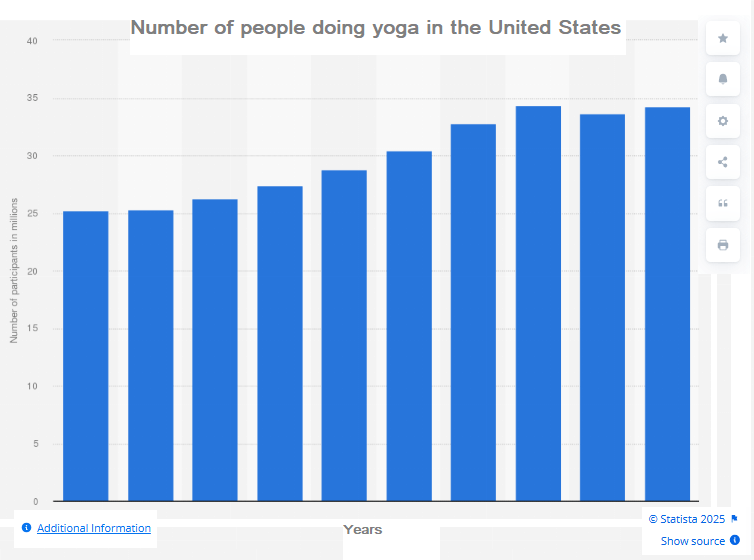
Additionally, in January 2025, MyFitnessPal is leading the fitness and sports mobile app, generating in-app revenues of about 16 million U.S. dollars. Here, Strava ranked second, with roughly nine million U.S. dollars in combined revenue via both platforms.
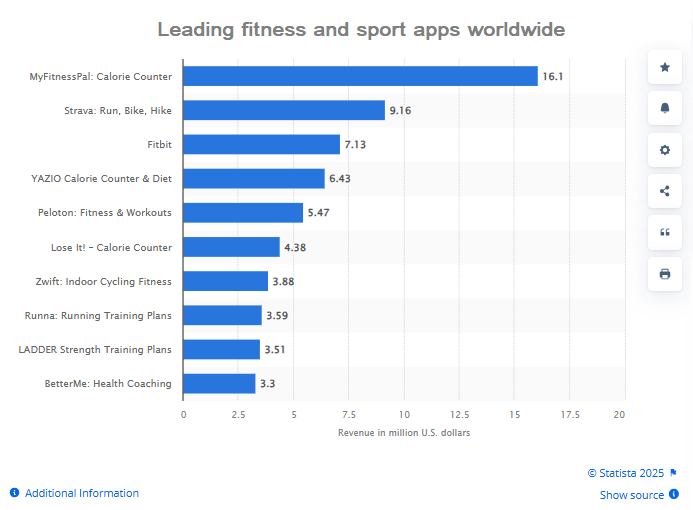
Are you still confused about the reasons to create a Yoga app?
Well, you can consider the following section for the same.
Why Create a Yoga App?
Learn about the reasons why you need to build an effective yoga app here.

The given list can help you.
► Greater Access to Yoga
With the help of the Yoga app, users can be able to get instant access to yoga. Yoga is all about identifying the right guru or teacher who can help in identifying and learning the right postures for health and fitness.
► Diversification
As an entrepreneur, you will know about the current market demands, which will help you to address the users’ issues by providing them with diversification in yoga apps.
Additionally, the adoption of yoga apps can assist the user’s progress, set personalized goals, and provide feedback.
► Engaging Users
If you want to engage potential users in your business, then creating a yoga app can help. It further helps the users to find great yogas that can be adopted daily. It helps the users to enhance their practice of yoga.
► Generating Revenue
Yoga apps can help generate regular income. Well, here the users should be able to make the yoga application unique, stand out, and profitable.
Here you can continue with effective revenue-generating strategies such as in-app purchases, in-app advertising, data monetization, and many others.
► Scalability
Building a yoga app can help extend the scalability of your business. Scalable apps help maintain performance and responsiveness even as the demand for the apps increases, they do prevent slowdowns and outages that can frustrate users.
Well, these are some of the common reasons that you can consider for your yoga app development.
Now, as we proceed with the yoga app development, let’s learn about how it works in the following section.
How Does a Yoga App Work?
When you enter the industry of yoga app development, it is essential to note how it works, right?
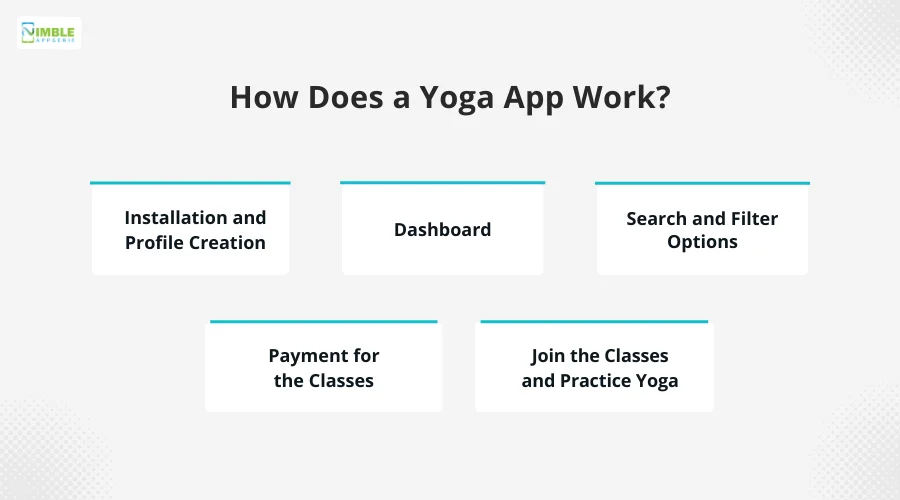
Well, the given section will help you with all that you expect.
1. Installation and Profile Creation
Under this platform, the users can continue with the app after downloading it from the Play Store or the App Store.
Later, the users can create a profile by adding all the potential information, such as name, types of yoga preferred, what timings they can select for practicing yoga, why they want to continue with yoga, etc.
2. Dashboard
After analyzing the users’ data, the app builds a complete dashboard that states a profile of the users’ preferences, with all the recommendations about their yoga practice.
This helps the users to identify potential yoga teachers that they can adopt in this scenario. The dashboard also includes the classes and all other details, stating the current user’s practices related to yoga.
3. Search and Filter Options
Now, with the help of search and filter options, the users can select the classes or yoga options that suit them the most.
This will help the users avoid clustered platforms, where the users can become confused about selecting any yoga practice. This is an important feature that helps users to find what they seek with the app.
4. Payment for the Classes
If the demos are available over the platform, they can switch to demos of one or two days, and then decide which classes or teachers will be suitable for them to go for yoga practice.
Later, the users can decide on the yoga options and can perform payment very easily by opting for diverse modes of payment.
5. Join the Classes and Practice Yoga
Then as per the features of the app, the users might record the live sessions and can even perform yoga live with their teachers via online channels.
It is one of the important ways to connect potential users over the platform. Along with this, some of the Yoga apps do have a feature of reviews and adoption for feedback.
These were some of the steps that the users can proceed with when it comes to identifying the process of how a yoga app works.
Now that you are ready to proceed with the yoga app development, let’s move ahead with the types of different features that you can include in the yoga app in the following section.
Features of the Yoga App
What are the top and relevant features you can include in the yoga apps?
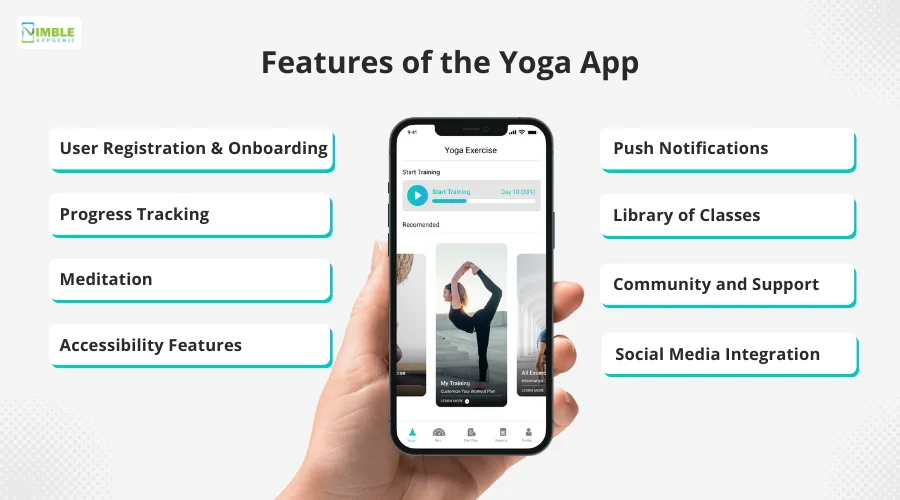
Let’s consider the following list of fitness app features for the same.
♦ User Registration and Onboarding
You can proceed with the user registration and onboarding feature, which is an essential feature when it comes to a yoga app.
Here, the user can set up a simple flow for the user to begin their journey with the yoga app.
♦ Push Notifications
Push notifications are a must-have feature when it comes to creating a yoga app. It is one of the features that helps the users to receive updates related to the recent classes, offs, shifting of class to another time, and much other information useful to the users.
♦ Progress Tracking
On the yoga app, users can track their progress successfully. This will even help the user to know and identify at what yoga stage or level they have reached and what they have to conquer.
These are digital tools that help users to monitor and access their progress.
♦ Library of Classes
Over the yoga app, users can find a library of yoga classes that they can join anywhere and anytime they want.
This library of classes is one of the important segments or features that users can consider when they log into the app.
♦ Meditation
Guided meditation sessions, with breathing exercises and relaxation techniques, can lead to holistic well-being.
A customized yoga app can help guide mindfulness and meditation sessions as an important part of the app’s offerings.
♦ Community and Support
Social sharing and community support an important yoga app feature that helps businesses connect with like-minded individuals, share experiences, and stay motivated.
Some yoga apps comprise community features, enabling users to connect with like-minded individuals.
♦ Accessibility Features
With this feature, businesses can ensure that their app is accessible to users of all abilities by including features such as adjustable font sizes, color contrast, languages, and many other elements.
♦ Social Media Integration
Social media integration is all about providing users with diversified platforms where they can share yoga sessions with their friends and family. It is an important feature that helps users to share their concerns in a simple way.
These are some of the common features that you can implement while considering the yoga app development.
Now, as we proceed further, let’s examine the top apps that are currently leading the industry.
Top Yoga Apps
When you enter the yoga industry, it’s essential to study and learn about your competitors who are already engaging your target audience.

So, here is a list of the best yoga apps to consider.
➤ Yoga Studio
On the yoga app, users can discover the ultimate experience with their teachers. The app is for every individual, whether they are a beginner or an experienced yogi the platform serves all.
Additionally, once the user downloads the app and gets access, no internet is required.
➤ Daily Yoga
Daily Yoga app helps users identify workouts such as yoga for weight loss and fat burn. It is a clear app with many beginner-friendly classes and is suitable for more intermediate students.
➤ Asana Rebel
Asana Rebel is a yoga app for every individual who wants to get fit, even wants to lose weight, and live a healthy lifestyle.
It is a wellness app that helps individuals design their own fitness plans with the help of a guide or coach.
➤ Yoga For Beginners by Yoga-Go
This is a suitable yoga app for beginners and even for more advanced yogis. Here, users can discover 600+ workouts for any needs, Somatic yoga workouts, Chair Yoga for seniors, and much more, all under one app.
➤ Glo
Glo is an online yoga, meditation, pilates, and fitness app that is designed to help the user feel better in body and mind.
Here, users can practice the app at home or on the go with the world’s best teachers. This will help users create a practice that’s unique to them.
➤ Pocket Yoga
Pocket Yoga recreates the experience among the users of being in an actual yoga studio through an online medium.
With the app, users can develop a custom yoga routine in minutes that helps them to practice yoga anytime and anywhere.
These are some of the top yoga apps that can be considered when you start building a yoga app. Well, you can consider the following section to evaluate the top steps for the yoga app development.
How to Develop a Yoga App?
Let’s consider the following steps.
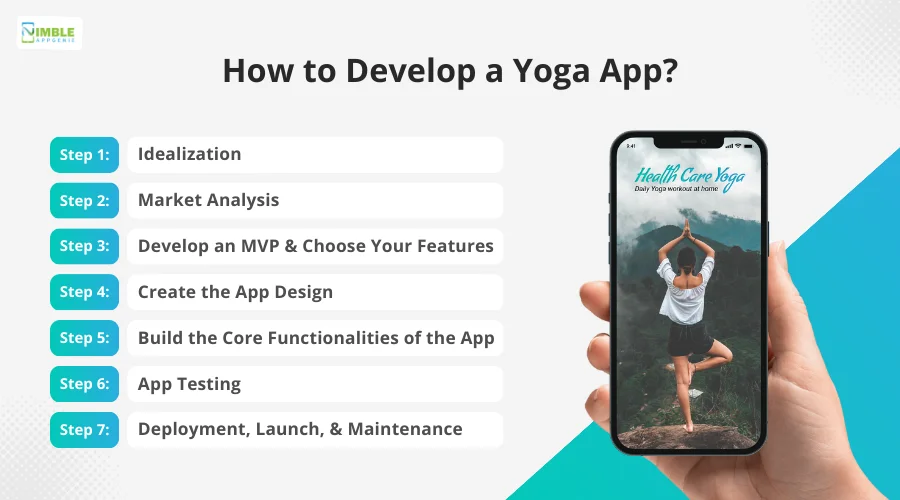
Step 1. Idealization
The first and foremost step that you cannot overlook is idealization. Here, you should have a mobile app idea for your yoga business.
You can discover the market and identify the potential gap that exists in the market, then form ideas accordingly.
The app idea helps businesses to plan their strategy and then helps them to state the steps and then proceed with the process.
Step 2. Market Analysis
Now, you can continue with the market research that is all about identifying the target users’ needs and demands.
Along with evaluating the gap that exists in the market, you should know what is in the trends are when it comes to yoga apps.
Here you can evaluate what competitors are doing in the market and how they are engaging their target users.
This step will help you to know a depth about the users as well as help you to learn about the market, through evaluating the current stats and needs of particular features in the competitive market.
Step 3. Developing an MVP and Choosing Your Features
Well, here, you can create a Minimum Valuable Product (MVP) that will comprise the diversified features included to engage and attract the potential users or early adopters in the industry.
An MVP begins with a clear understanding of who the ideal customer is and whether your app is sufficient to reach the target audience or not.
It will help you identify if your app can serve the desired purpose and then be able to succeed in the competitive landscape.
It is one of the significant criteria that you need to note while building the complete app. Under this step, you can select the number and type of features that will be suited best for your app.
Step 4. Create the App Design
Now, it’s time to build a complete fitness app design. Here you can be able to select the different designs that are based on the themes of the app.
Under the yoga app design, you should be able to include all the different segments helpful to the users to address their issues related to navigation, simply operating the app, and much more.
The user should build the overall design of the app by creating the wireframe and prototype. This part of the process will help you to frame the structure of the project.
Step 5. Build the Core Functionalities of the App
Now it’s time to create the core functions of the app, all including the technologies and programming languages such as Swift and Kotlin, and tools including Xcode or Android Studio.
The yoga app tech stack should be effective enough to support all the types of features that the users want to include in it.
It is all about the technologies that will allow the developers to build a responsive and user-friendly interface with high performance that is built for mobile devices.
The mobile app tech stack should include the set of tools and technologies that businesses should use to build and run a software application.
In this step, you will create a complete app by combining all the useful steps required to build the platform.
Step 6. App Testing
Well, just as your app is ready to launch in the market, it doesn’t mean it is bug-free. Here, all you need to do is test the yoga app under different circumstances.
Mobile app testing can help you identify the bugs and errors that you might find while building the complete app.
Additionally, this step will help the users to validate the appearance, performance, and functionality of the apps across different devices.
You can consider different types of app testing here, including functional testing, performance testing, security testing, usability testing, compatibility testing, localization testing, and many others.
Step 7. Deployment, Launch, and Maintenance
Now, users can deploy the app across platforms, including Android and iOS. It’s all about the deployment of the apps according to the target audiences.
Well, here you can launch the app in the competitive market. You should proceed with the app launch after evaluating the current date.
Along with creating the app, maintaining it is another perspective that you might consider. Mobile app maintenance can help sustain in the competitive landscape.
These are all the important steps to consider while building a yoga app efficiently. Now, let’s begin with the cost or resources in the following section.
Cost to Create a Yoga App
What’s the cost to build a yoga app?
The average cost to develop a yoga app can vary from $20,000 to $200,000, which totally depends on different factors including complexity, design, technology stack, and much more.
Evaluating the complete cost can help you decide on different elements that can impact the overall performance and process of creating your dream app.
Want to learn more about the same?
Let’s examine the given section.
What Are the Factors Impacting the Cost to Build a Yoga App?
Multiple factors impact the mobile app development cost.
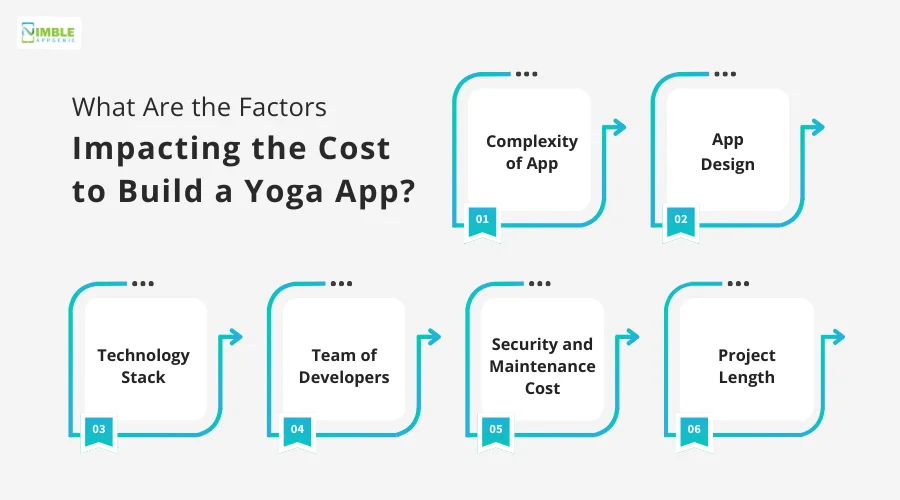
Let’s learn them all in brief.
1. Complexity of App
A complicated app may lead to an increase in the overall yoga app development cost.
Please note that complex apps with advanced features can cost more. Along with this, the large size of the app will result in more cost, and vice versa.
2. App Design
Here, a complicated design of your app will enhance the overall cost to build the yoga app.
Advanced UI elements and custom illustrations can increase your overall cost to build the yoga app.
3. Technology Stack
If you are adding complicated features to the app, then there is a chance that it might impact the technology used in yoga app development.
Here, the cost can vary from $5000 to $15,000, depending on the total cost of the app.
4. Team of Developers
Here, the team of developers will be impacted by two important factors, including the skills and location of the developers.
The cost can vary depending on location; for example, if you hire mobile app developers from the Asian region, it can vary from $20,000 to $200,000.
However, if you hire them from the United States or the United Kingdom, the cost can vary from $40,000 to $400,000.
5. Security and Maintenance Cost
When you create the yoga app, there is one factor of app security that your app might be impacted by.
If you select the complicated mobile app security tools, it will result in a high cost. The same goes with the app maintenance process.
6. Project Length
The longer and more complicated the project is, the higher the total cost. This may be due to the extended need for resources, including designers, developers, and testers.
Delays in the cost can cause different issues, including cost overruns, the need for reworked timelines, and damage to the reputation of the brand.
Till now, we have discussed the yoga app, its related market analysis, reasons to build the app, features, top apps, steps to build the yoga app, and its defined costs along with the factors impacting the same.
Now, let’s evaluate the money-making strategies when it comes to yoga app development in the given section.
How Does a Yoga App Earn Money?
Well, when it comes to the yoga app, it can be difficult for you to earn a certain amount that will be helpful to keep running the business.
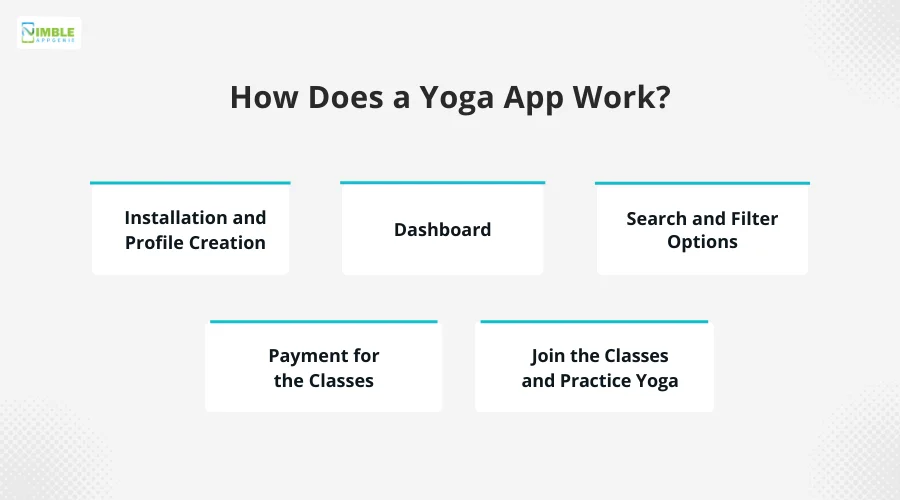
Let’s examine the top yoga app monetization strategies below.
• In-App Purchases
Through in-app purchases, users can buy individual items or features within the app. These features can be many based on the current preferences of the users.
Along with this, with the assistance of in-app purchases, it might include personalized coaching, advanced yoga routines, etc. Well, it could become a permanent source of revenue.
• Freemium Model
The freemium monetization model is a popular strategy that is used and adopted by yoga mobile apps to generate great revenue.
Through the freemium model, the app is free to download, although certain features and content can be available to be purchased later. This can become a regular source of revenue for your business.
• Data Monetization
Data monetization is one of the essential strategies that cannot be overlooked. Here you can collect a variety of data from the users and then use it to earn significant revenue.
This strategy can be helpful to businesses to create a measurable economic benefit. It is an important strategy where you can use data internally to enhance processes and realize new innovation opportunities.
• Subscription Model
Users can select the subscription model, where they can choose the pricing model that they prefer the most. Additionally, with the help of a subscription model, the users will not need to pay for each class separately.
It is a regular income-earning model that will be adopted by the businesses that will be profitable for the users too.
• Crowdfunding
Crowdfunding is an important method to earn money and to inject funds into the venture. It can be a medium to increase your overall capital of the yoga business.
Through crowdfunding, users can raise small amounts of money from a large number of individuals, and it can add to their capital.
These are some of the money-making strategies that you can consider when it comes to yoga app development.
Well, as we proceed further, there can be different challenges that you can consider while creating a yoga app.
Let’s evaluate the challenges in the given section.
What are the Challenges Faced by Businesses While Creating a Yoga App?
When entering the industry, there can be certain challenges that your business can face.
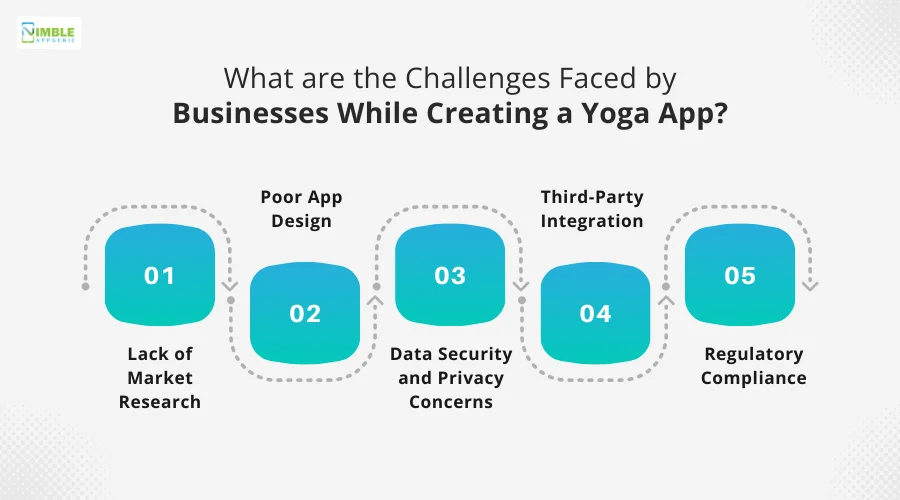
Let’s evaluate them all below.
➤ Lack of Market Research
If you haven’t performed the market analysis properly, then it can lead to multiple issues and challenges, such as ignoring the target audience and launching the app without evaluating the current gap in the competitive market. This will automatically result in app failure.
➤ Poor App Design
With the lack of app design, it can attract and retain users in the long run. A lack of app design with a cluttered interface can confuse users and might result in higher abandonment rates.
The users can lose interest in your app, which can become the biggest challenge.
➤ Data Security and Privacy Concerns
Poor data security can even result in losing your app. Additionally, data security and privacy are key challenges in the development of wellness apps.
Your app can suffer from poor app security, and this will become one of the severe issues or a barrier to retaining users in the long run.
➤ Third-Party Integration
Considering the seamless integration with wearables and third-party APIs is creating a major challenge. Here, users can adopt wearable devices to monitor their health and fitness.
Avoiding these parameters can be a challenge faced by businesses while creating a yoga app.
➤ Regulatory Compliance
One of the biggest challenges that your app might face is compliance. It’s all about complying with the fitness regulations. If your app doesn’t comply with such issues, then this can impact the overall performance of your yoga app and its ability to sustain in the competitive environment.
These are some of the challenges that you should consider when it comes to creating a dream yoga app.
Well, if you are still confused about the yoga app development, then connecting with an experienced company can help.
Connect with Nimble AppGenie and Create your Dream Yoga App
Are you searching for an experienced app development company?
Well, connect with Nimble AppGenie, we are the leading Fitness App Development Company focused on delivering quality and integrity.
Our team is ready to help you with all the different ideas that can fulfill the objective of leading the competitive industry.
Conclusion
When it comes to yoga app development, it’s important to consider the important steps. These steps can begin with market analysis and can end with the launch of the app.
Some features that you can include here can be user registration, push notifications, meditation, social media integration, and accessibility features.
Under this factor, the diversified cost that you can adopt can vary depending on different factors such as the complexity of the app, design, security and maintenance cost, technology stack, and team of developers.
Additionally, there are different challenges that you can consider, such as poor app design, lack of market research, regulatory compliance, and third-party integration. Well, connecting with a leading yoga app development company can be helpful.
FAQs
Building a yoga app requires a series of steps that include the following measures.
- Market Analysis: It’s important to consider market evaluation through evaluating the competitive industry and identifying the target audience.
- Create app design: Now, it’s time to develop an app design including structuring the app to attract and engage the potential users.
- Build the tech stack: A tech stack is what can support your app feature by selecting the right technologies. It can be based on a diversified platform.
- Creating the App: Now, you should consider all the steps and then build the complete app.
- Testing the App: Well, it’s essential to test the app over different platforms and types of testing such as acceptance testing, integration testing, performance testing, and many others.
- Deployment, Launch, and maintenance: In the end, you can deploy the app over different platforms and can launch the app successfully. Along with this, you can maintain the app after considering useful steps.

Niketan Sharma is the CTO of Nimble AppGenie, a prominent website and mobile app development company in the USA that is delivering excellence with a commitment to boosting business growth & maximizing customer satisfaction. He is a highly motivated individual who helps SMEs and startups grow in this dynamic market with the latest technology and innovation.
Table of Contents






No Comments
Comments are closed.